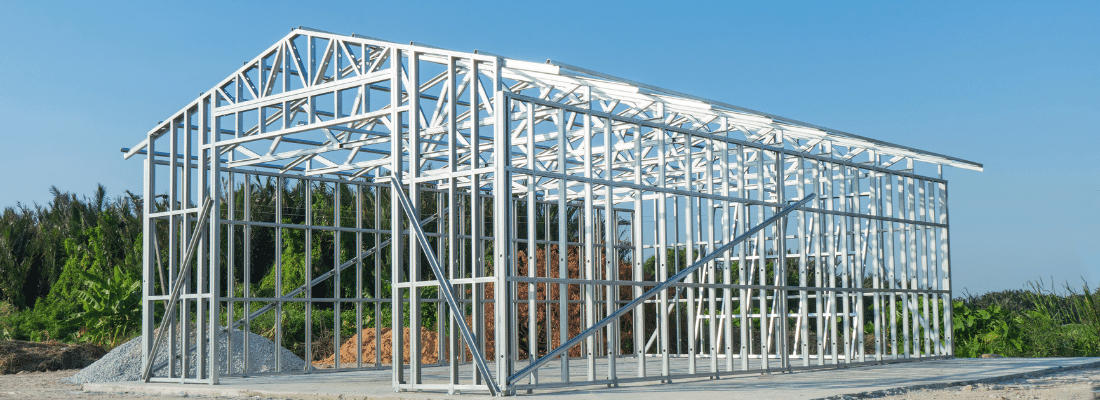Cold-Formed Steel - What, Where & Why?

What is Cold-Formed Steel (CFS)?
In steel construction, there are (3) main families of steel members:
- Cold-formed members;
- Hot-rolled members;
Cold-formed steel refers to zinc-coated steel sheets, strips, plates or flat bars fabricated using rolled-formed machines (press or bending brake processes) to produce cold-formed steel structural sections. The sections produced can be categorized into (3) areas:
- Sections
- Panels
- Decks
In Canada, the standard for design of cold-formed steel members are defined in the CSA S136-16, North American specification for the design of cold-formed steel structural members.
Where is CFS used?
Cold-formed steel framing is commonly used as (5) products on the CSSBI website: (https://cssbi.ca/products)
- Steel Building Systems
- Steel Studs & Joists
- Steel Siding & Cladding
- Roof Deck & Composite Floor Deck
- Steel Roofing
Lightweight steel framing (LSF) construction is typically composed of lipped channels commonly referred to as “studs” which vary in gauges from 0.836 to 2.997mm, with a yield strength of 228 to 345 MPa.
Other cold-formed shapes typically used are tracks, Z-bars, hat-channels (also known as furring channels), T-shapes and tubular sections. These members can vary in size, with non-structural members being as small as 41mm studs or 22mm furring channels to structural 457mm deep floor joists.
LSF can also be configured to create roof trusses, wall panels, floor panels, lateral force resisting systems, steel decks, steel siding and cladding.
Why choose CFS?
With such a variety of materials being used in today’s construction projects, the following is a list of advantages:
Cost Savings
- Significantly lighter building material compared to industry alternatives such as timber, concrete and masonry resulting in reduced construction costs for lateral force resisting systems and foundations.
Design Benefits
- Available design guides, software and technical resources.
- Strength-to-weight ratio that is up to seven times greater than that of dimensional lumber.
- Consistent manufactured product with high versatility and innovative capabilities.
Resilient
- Standard coating from galvanization/galvalume.
- Alternative coatings for severe environmental conditions available.
- Provides protection from corrosion.
- Referenced durability experiments indicate estimated coating lifespan in excess of 100 years.
- Can be constructed in extreme cold weather conditions without the need of heating.
Sustainable
- Highly sustainable material containing an average of 25% recycled content and having a recycling rate of more than 90% at the end of its lifespan.
- Dimensionally stable and can be fabricated to exact specifications to minimize on-site waste.
Fire Safety
- ULC rated designs available for various building code requirements.
- Non-combustible members reducing the fuel source compared to wood construction.
- Referenced fire experiments show structural reduction retention factor remains 1.0 for temperatures up to 700*F and stiffness retention factor remains 1.0 up to 200*F
Panelized
- Factory penalization of mid-rise steel building components (wall and floor panels) can be completed for mass production, prefabricated and assembled in a factory setting and erected on site to reduce the base building construction time.
- For mid-rise construction mobile cranes can be used for erection.
Key Takeaways!
To summarize the information outlined above, the advantages of cold-formed steel are abundant, from decreasing construction costs and time to high-longevity. Consider cold-formed steel as the building material for your next project!
Please continue to follow our CFS Blog Series as we will continue to elaborate on the rest of the CFS world!
References
- “Fire Performance”, CSSBI Technical Bulletin, Volume 1, Number 1
- “Section 2 – Fire Resistance of Steel Systems”, Fire Factors for Steel Buildings, CISC, 2006
- “Durability of Galvanized & Galvalume Steel Framing”, CSSBI Technical Bulletin, Volume 2, Number 1
- “Metallic Coating Specifications for Cold-Formed Steel Framing in Canada”, CSSBI Bulletin Volume 7, Number 9, February 2015
- https://cssbi.ca/products/steel-roofing
- https://cssbi.ca/products/roof-deck-composite-floor-deck
- https://cssbi.ca/products/steel-siding-cladding
- https://cssbi.ca/products/steel-studs
- https://cssbi.ca/products/steel-building-systems